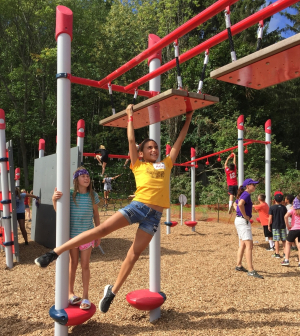Why playgrounds matter in rural America: insights for rural donors and funders
 The neighborhood playgrounds are a critical asset that helps make communities resilient places where kids can thrive and residents can connect. But in many rural communities across the country, factors like physical distance, countywide recreation policies, and the lack of a local tax base can limit children’s ability to access these spaces and the benefits they generate for health and well-being. This fact gains even more urgency when considering the deep disparities in rural childhood health outcomes.
The neighborhood playgrounds are a critical asset that helps make communities resilient places where kids can thrive and residents can connect. But in many rural communities across the country, factors like physical distance, countywide recreation policies, and the lack of a local tax base can limit children’s ability to access these spaces and the benefits they generate for health and well-being. This fact gains even more urgency when considering the deep disparities in rural childhood health outcomes.
Through decades of work partnering with rural communities, KABOOM! has come to understand that location is critically important in shaping the opportunities and barriers that kids and communities experience.
Addressing health outcomes with playspace equity
“Playspace equity” means every child has access to playspaces that deliver critical outcomes for child health, development, learning, and social and emotional well-being — regardless of factors such as race, ethnicity, or family income. KABOOM!, a national nonprofit, is working to achieve that vision.
For more than 23 years, KABOOM! has worked with communities to transform 17,000 playspaces, engage more than 1.5 million community members, and expand access to playspaces for 11 million kids. The community is at the heart of the process, with residents and kids engaged throughout the design, construction, and maintenance phases to ensure that the final playspace reflects their unique needs and expectations. According to a survey, 94 percent percent of KABOOM!-led respondents believe their playground project helped strengthen relationships among neighborhood residents and among community partners.
The approach also inspires optimism, as community members work toward a collective goal that will benefit future generations. KABOOM!’s engagement process focuses on the existing assets in each community has and supports a greater vision for what it would like to see for its kids.
Playspaces: supporting broader strategies to support rural communities
Last year, KABOOM! teamed up with the Colorado Health Foundation and the community of Trinidad, Colorado, to complete a project at the Las Animas Fairgrounds. Trinidad is a small rural community with just over eight thousand residents, 20 percent of whom experience poverty at some point during the year. Throughout the engagement process, local partners cited high rates of obesity and the mental health impacts of social isolation and increased time using technology as top concerns.
Together with the community, KABOOM! helped build an Adventure Course for teens that serves more than a thousand kids annually. The Adventure Course also provides a community gathering space, which is critically important in a location where public space is limited or hard to access. Afterschool programs and home school students use the space frequently, and the local fire department can be spotted on the course during training exercises.
In Bastrop County, Texas, KABOOM! worked with a local nonprofit, Bastrop County Cares, to build a playspace in Stoney Point. The support from multiple agencies and resident leadership ensured the project would be part of a greater effort to develop county spaces for families in the region. With the help of funding from the St. David’s Foundation, KABOOM! was able to support the community and build on the existing coalitions that had been established. The community reports a measurable difference in play activities, with more than 90 percent of respondents to a survey of build volunteers affirming that the amount of time kids spend playing has increased.
In western New York, KABOOM! partnered with the Rural Revitalization Corporation, the City of Salamanca, and the Ralph C. Wilson Foundation. Salamanca has a population of just over five thousand residents, with a little more than 20 percent experiencing poverty. The city sits on top of the Tribal lands of the Seneca Nation and, due to lack of funding and a smaller tax base, has found it difficult to secure support for capital projects like park infrastructure. But KABOOM! was able to help the community build a state-of-the-art Adventure Course that now provides more than nine hundred and fifty children with a safe place to play. Six months after the build was complete, playground participation had increased by 20 percent.
A KABOOM!/funder partnership is well positioned to respond to a number of challenges faced by funders looking to engage with rural communities:
- The KABOOM! model generates a cohort of volunteers — many of whom have had no contact with the funder in the past. A successful KABOOM! build can be a springboard for other community-led community development projects.
- The local site sponsor, whether a church, community based-nonprofit or a rural Housing Authority (for example), often expands the funder’s network of interested and eligible grantees and responds directly to the frequently heard funder’s lament, “There is no one to fund.”
- The model is scalable and creates a level of interest in surrounding communities.
- The funder is the administrative intermediary with KABOOM! and can mitigate the challenges faced by rural communities in accessing outside resources.
In our conversations with rural communities, residents often express frustration that national programs don’t have anything for them: most best practice models are built on urban density. The KABOOM! partnership provides an opportunity for a very active rural engagement that is scaled to communities’ needs and culture — all in the context of a community-led design and build process. It’s an example of how funders and donors can bring resources to rural places that are more than the sum of the parts and a reminder that the best rural philanthropy supports a sustainable community ownership structure.
This post originally appeared on the Giving Compass website.







